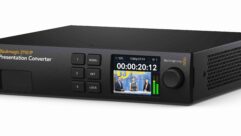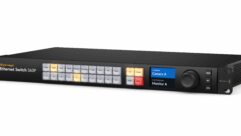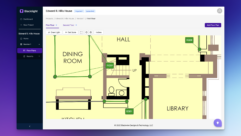SIMPLE BY DESIGN
Jan 1, 2002 12:00 PM,
By Gregory A. DeTogne
At Gentex Corporation, it is widely understood that business is a matter of smoke and mirrors. To the average person, that kind of thinking may sound deceitful, but at Gentex it’s quite natural. That’s because the Zeeland, Michigan-based manufacturer logged over $297 million in sales of fire alarms and automatic-dimming car mirrors in fiscal year 2000.
Today, under the guidance of CEO Fred T. Bauer, Gentex employs 1590 people and occupies a sprawling corporate campus. While other companies are tanking in the wake of a battered economy and the repercussions of September 11, Gentex remains on the move, having just expanded one of its main buildings to include a multipurpose room designed to facilitate a number of activities including large meetings.
Bringing audio to the environment was a task given to Group Signal Inc., a systems integration firm headquartered in nearby Holland, Michigan. Having successfully completed audio installs within other large spaces on the corporate campus, Group Signal approached this design/build assignment knowing the client’s general expectations in advance. Says Gary Zandstra, head of Group Signal sales and marketing, “Gentex, like a lot of other corporations in our current economic climate, was seeking to get maximum value for dollars invested.”
To that end, Zandstra sharpened his pencil and came up with a design for the company that used high-quality gear and came in under $15,000 installed, to boot. Designed around loudspeakers from Community’s CPL Series and a P4800 DSP processor from Shure, the system also met another of Gentex’s criteria admirably: to be so easy to operate that anyone could master it.
Many of the regular meetings held in the large meeting room involve multiple presenters and capacity audiences. The presenters, as a rule, have no experience whatsoever with pro audio gear. Taking this fact into consideration, along with the reality that no permanent A/V staff is maintained at Gentex, Zandstra made the system about as complicated to operate as a toaster. In total, there are only five controls mounted on a custom wall panel: One each for two wireless microphone systems kept at hand, one for gain on a CD player used for background music when meetings aren’t being held, one to mute the page circuit, and one to control various audio scenes.
“Quick, easy control for the scenes was vital, as the nature of the meetings in the room is constantly changing,” Zandstra relates. “While the most commonly used scene utilizes all the loudspeakers, others are also available for when the presenter’s platform is situated on the north, south, east or west walls. Each of these scenes requires its own system configuration for the five loudspeaker zones I created.”
Programming the system to meet the room’s needs was literally made as simple as its operation thanks to the presence of Shure’s P4800 processor. Zandstra reports that if his experiences at Gentex are any indication, the device is so easy to set up that most will have it up and running in just about any application without even opening the manual.
Performing all initial P4800 programming duties at Gentex himself, Zandstra used the feedback reduction circuitry (called DFR for Digital Feedback Reduction) on his wireless microphone inputs along with 10-band parametric equalization. “Within the drag-and-drop architecture, the system build was indeed quite painless,” he says of the process. “The task of adding parametric EQ to the system’s background music-generating CD player/cassette deck required no more than a few mouse clicks. The same held true of placing automatic gain control on paging functions and implementing other processing tools.”
With the drag-and-drop programming of the P4800, once system inputs enter the device, they are mixed together prior to being sent off for parametric equalization. After exiting the equalizer circuitry, they pass through a limiter and are then routed to a splitter, which distributes the feed according to the selected system configuration to each of the five zones. Delay is also introduced at each output, again according to the parameters of the desired preset.
“The DFR circuit within the P4800 was put in place as more of a precaution than anything else,” Zandstra says of the unit’s feedback-fighting module. “The system is set up to provide maximum gain before feedback, so it’s really just a safety valve in case something doesn’t go as planned. We’re using five fixed and five dynamic feedback-fighting filters, which we left set in an automatic sensing mode.”
Power for the system comes from a 6-channel, model MPA-450 amplifier from Miles Technology Inc. With one channel reserved for future expansion, the amp’s other five active, 75-watt channels drive 10 loudspeakers at a rate of two apiece while shouldering a 4-ohm load. In keeping with the expressed goal of maximum bang for the buck without skimping on quality, Zandstra’s specified loudspeakers from Community’s CPL Series fit the bill nicely, bringing out-of-the-box performance to the project along with ready-to-hang aesthetic qualities.
“They went up very quickly,” Zandstra says of the speaker hang. “Using nothing more than nuts and washers and the provided brackets, we mounted the CPLs to the low steel supporting the room’s ceiling. As for performance, they easily provided the coverage and clear intelligibility necessary to the project. It was no surprise because we had the same experience with them before on the Gentex campus.”
Once installed in September 2001, the Gentex system was fine-tuned by a Group Signal technician, Doug Ardy. Managed by Steve Driesenga, the project came in according to budget — and beyond expectations when it came to performance and operation. “I haven’t heard back from the client since I trained them how to use the system,” Zandstra notes. “That’s a good sign, because I know they are using it all the time. Silence on their part, in this case, I can safely take to mean that nothing is wrong, and the system is indeed as easy to operate as we set out to make it. We built it so anyone could walk in and use it, and that’s just what’s happening.”
In the grand scheme of things, Zandstra feels that the future holds a bright spot for these types of value-engineered, DSP-based systems. “The sudden flourishing of systems like this isn’t just related to a slow economy,” he believes. Even when times get better, you’ll continue to see them proliferate in many applications, including churches and other mid-size venues. “Their ease of installation, setup, value and performance is all based upon sound engineering principles, not marketing gimmicks directed at people just looking to save a buck. As far as the future is concerned, the need for systems simplicity will continue to grow as well — especially on the contractor side — and manufacturers will step in with products to meet that need. To create what we have here at Gentex a few years ago would have been more difficult and more expensive. We would have had to install both a separate mixer and a DSP processing box. Today, devices like the Shure P4800 have made installation practices like this unnecessary. Where will this trend take us? Time will tell. All we have to do is stick around and find out. If we’re really lucky, the act of reading the manual along the way will continue to be optional as well…”
Gregory A. DeTogne is a writer, communications consultant and owner of an editorial public relations firm in Libertyville, Illinois, that specializes in pro audio accounts.
PLAIN ON THE OUTSIDE, FANCY ON THE INSIDE
Versatile and Simple Signal Processing
At the heart of the versatile Shure P4800 processor is an intuitive, drag-and-drop architecture offering control over just about any processing function imaginable found between the mixer and amplifiers within installed systems. Among these powerful features is a 4×8 matrix mixing section that enables users to quickly assign any of the unit’s four inputs to any of the eight outputs, with provisions for adjusting levels and signal polarity along the way. With the simple click of a mouse, processing blocks can be added to the signal path; these include Shure’s DFR feedback reducer, a number of EQ options, automatic gain control, limiting, compression, gating and delay. Capable of being applied in any order to any input or output, each processing block can also be copied and pasted to duplicate processing across multiple channels. To better meet the demands of eleventh-hour hardware changes and other unexpected revisions, blocks can additionally be added or deleted as required, while adjustments can be made on the fly, with all changes being heard in real time.
Visual indicators provided with the P4800 include an LED signal-metering display found on the unit’s front panel that allows signals passing through the device to be monitored without the use of a PC. On screen, full input and output metering is supplied when the software is in use. DSP resource meters at the bottom of the main window keep tabs on available processing power.
As a final complement, the P4800 is fully compatible with both AMX and Crestron control systems, is equipped with RS-232 and RS-422 ports, and supports simple controls such as the potentiometers and switches used in Zandstra’s bone-simple, custom wall control panel in the Gentex installation.
THE SOUND AT GENTEX
The 10 Community cabinets were all CPL23-W models, which Zandstra selected from stock painted white (indicated by theWsuffix in the model number) to blend-in almost imperceptibly within the room. Two-way, full-range boxes, the CPL23s have a compact stature at 11.8 inches high. They house single 8-inch low frequency drivers topped off by coaxially mounted 1-inch dome-style high-frequency transducers. Engineered with direct-radiating, low Q, 90°×90° horizontal and vertical dispersion patterns, the enclosures are made from sturdy ¾-inch MDF board and come with perforated, acoustically transparent steel grilles. Operable between 70 Hz and 20 kHz, the low-profile loudspeakers, despite their diminutive size, are additionally capable of posting 114 dB SPL peak output levels. Mounting provisions (including a steel bracket, six built-in rigging points and threaded inserts for Omnimount-style brackets, and a stand adapter) come with the contractor-friendly packages, and these came in handy at Gentex.
FOR MORE INFORMATION
Community
www.loudspeakers.net
Circle 190 on Reader Service Card
Miles Technology Inc.
www.milestech.com
Circle 191 on Reader Service Card
Shure
www.shure.com
Circle 192 on Reader Service Card










